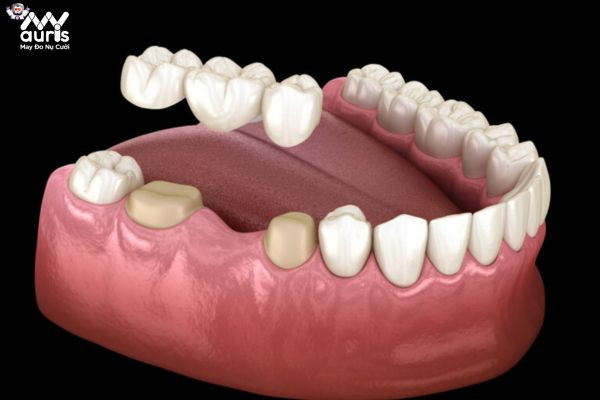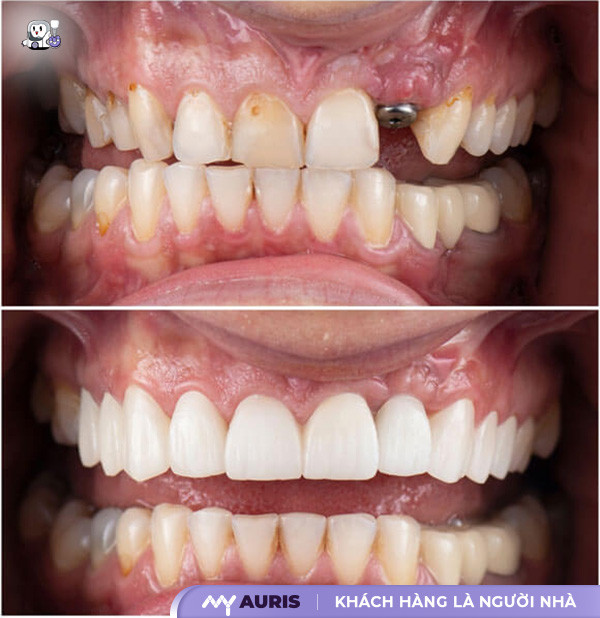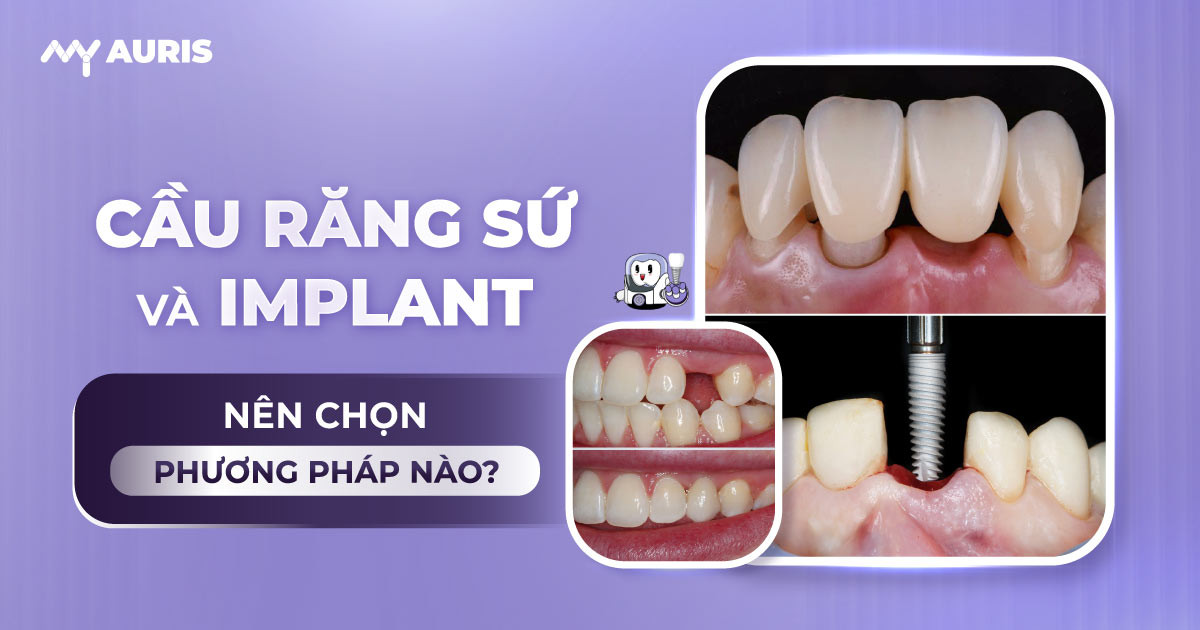Missing teeth? Discover the difference between dental bridges and dental implants! Both solutions restore chewing function and aesthetics. However, dental bridges and implants have very different procedures, timelines, costs, and durability. Let My Auris help you understand the details to choose the best method for your smile!
What are Dental Bridges and Implants? How do they differ?
When you lose a tooth, restoration with dental bridges or dental implants are two common options. Both aim to replace missing teeth, restoring chewing function and aesthetics. However, the techniques, time, cost, and long-term effectiveness of each method differ significantly.

What are Dental Bridges?
Dental bridges are a fixed dental restoration method that involves preparing at least two natural teeth adjacent to the missing tooth area to serve as abutments, then placing a series of dental crowns on top. The prosthetic tooth in the middle does not have a natural root but is supported by the adjacent teeth.
Dental bridges are typically used for cases of 1 to 3 adjacent missing teeth, when the neighboring teeth are healthy and can be prepared as abutments. The procedure is quick, usually taking only 3–7 days to complete. However, this method requires grinding down adjacent teeth, affecting healthy tooth structure.

What are Implants?
Dental implant placement is a technique that uses a titanium post to replace the lost natural tooth root. The implant post is surgically placed directly into the jawbone, and then a dental crown is attached on top. This method does not require grinding adjacent teeth and helps maintain bone density, preventing jawbone loss.
Dental implants are suitable for cases of a single missing tooth, full arch tooth loss, or long-term tooth loss. The completion time is longer than for dental bridges because the post needs time to integrate with the bone, typically 2–6 months depending on the patient’s condition and treatment technique.
Similarities between Dental Bridges and Implants
- Both are fixed dental restoration solutions and cannot be removed daily like traditional dentures.
- They help restore chewing function, improve aesthetics, and support clear pronunciation.
- Both require a specialized dentist and should be performed at a reputable dental clinic.
Differences between Dental Bridges and Implants
| Criterion | Dental Bridge | Dental Implant |
| Requires tooth grinding | Yes (grinding 2 adjacent teeth) | No |
| Maintains bone density | No | Yes (post integrates with bone) |
| Procedure time | 3–7 days | 2–6 months |
| Durability | 7–10 years | Over 20 years |
| Cost | 5–10 million VND/tooth | 15–30 million VND/tooth |
| Surgical intervention | No | Yes |
| Suitable for full arch tooth loss | Not suitable | Can be performed (All-on-4/6) |
| Risk of bone loss after restoration | Can occur | Does not occur |
| Success rate | ~85–90% | >95% |

Should you choose a Dental Bridge or an Implant in each specific case?
Missing one or two adjacent teeth – with good jawbone
In this case, dental implant placement is the preferred solution. Implants are directly integrated into the jawbone, eliminating the need to grind adjacent teeth. Fixed tooth restoration using a titanium implant post and a zirconia crown offers a lifespan of over 20 years. This method maintains bone density, preventing long-term jawbone loss.
However, the cost is approximately 15–30 million VND/tooth and takes 2–6 months to complete.
Missing 3 or more teeth – with good jawbone
Both dental bridges and implants can be applied. If the budget is limited, a linked dental bridge is a more viable option (costing 5–10 million VND/tooth, with a completion time of 3–7 days). However, it requires grinding down adjacent natural teeth, affecting healthy tooth structure. Conversely, if durability is a priority and you want to restore chewing function almost like natural teeth, implants are still a better choice.
Long-term tooth loss – suspected bone resorption
Dental bridges can cover the gap but do not prevent bone loss. In contrast, implants help maintain bone density and limit jawbone resorption. If bone loss is severe, the dentist may recommend bone grafting before implant placement. This case requires detailed consultation from a specialized restorative dentist.
Elderly patients – with compromised general health
If a patient has systemic diseases such as diabetes, heart conditions, etc., and cannot undergo surgery, dental bridges will be considered as they do not involve bone intervention. However, it is essential to ensure that the abutment teeth are strong and the gums are not inflamed. Implants may not be suitable if the overall health condition does not permit it.
Full arch tooth loss – requiring full arch restoration
Dental implant placement with All-on-4 or All-on-6 techniques is an effective full arch restoration solution, allowing for chewing function similar to natural teeth, high longevity, and natural aesthetics. However, the cost is significantly higher. Full arch fixed dental bridges are less commonly used in this case due to the requirement for strong abutment teeth and their inefficiency in comprehensive restoration.

Detailed Comparison Table: Dental Bridges vs. Implants regarding Cost, Durability, and Aesthetics
Below is a detailed comparison table to help you easily choose the option that suits your dental condition and personal finances.
Cost Comparison
Cost is the primary factor that most patients consider when weighing between dental bridges and implants. According to surveys from many reputable dental clinics:
| Criterion | Dental Bridge | Dental Implant |
| Average cost | 5–10 million VND/tooth | 15–30 million VND/tooth |
| Additional costs | Possible (if adjacent teeth are weak) | Possible (if bone grafting is needed) |
| High technical requirement | Medium | High |
| Procedure time | 3–7 days | 2–6 months depending on individual condition and implant type |
Considering the initial cost, dental bridges appear more economical. However, in the long run, implants can help reduce re-restoration or repair costs due to their superior durability.
Durability Comparison
| Criterion | Dental Bridge | Dental Implant |
| Average lifespan | 7–10 years | Over 20 years with good care |
| Success rate after 10 years | ~85–90% | >95% |
| Ability to maintain bone density | No | Yes (due to integration with the jawbone) |
| Long-term risks | Can cause bone loss, damage to adjacent teeth | Peri-implantitis if not properly cared for |
Dental implants are a highly durable option, suitable for those seeking long-lasting and stable tooth restoration. Meanwhile, dental bridges remain a good choice for cases where bone conditions or financial resources are insufficient.
Aesthetics Comparison
| Criterion | Dental Bridge | Dental Implant |
| Mimicry of natural tooth shape | Good, but dependent on adjacent teeth | Good, independent, fully mimics natural tooth |
| Natural appearance | Quite high | Very high |
| Color integration capability | Good with all-ceramic or zirconia crowns | Very good if premium ceramic crowns are used |
| Impact on gums | Gums may recede over time | Good compatibility with gums |
Dental implants offer aesthetics almost identical to natural teeth, especially when using zirconia crowns or other premium materials. Meanwhile, dental bridges can still provide a beautiful appearance but are more susceptible to issues if abutment teeth weaken or gums recede over time.
Risks and Considerations when Choosing Dental Bridges or Implants
Below is a detailed analysis of the risks and considerations to be aware of when deciding between dental bridges and dental implants:
Common Risks with Dental Bridges
Dental bridges are a popular restoration method due to their lower cost and quick completion time (3–7 days). However, grinding down natural teeth to serve as bridge abutments carries several potential risks.
Loss of healthy tooth structure: To place a dental bridge, the dentist must grind down at least two teeth adjacent to the missing tooth. This permanently removes tooth structure and can cause prolonged sensitivity.
Pulpitis in abutment teeth: If the tooth preparation technique is inaccurate or post-bridge care is inadequate, the abutment teeth may develop pulp inflammation, pulp necrosis, or even require root canal treatment.
Risk of jawbone loss: Since dental bridges do not have a tooth root embedded in the jawbone like implants, the bone at the site of the missing tooth will not be stimulated and may gradually resorb over time.
Limited lifespan: The average lifespan of a dental bridge is 7–10 years. If an abutment tooth fails, the entire bridge must be removed and replaced.
Risks with Dental Implant Placement
Dental implant placement is a technique that involves surgically placing a titanium post into the jawbone, restoring function almost like a natural tooth. However, this is a complex surgical procedure that requires good health conditions.
Risk of peri-implantitis: If oral hygiene is not properly maintained or regular check-ups are missed, bacteria can attack the tissue around the implant post, causing gum inflammation, bone loss around the implant, and potentially leading to implant failure.
Need for bone grafting or sinus lift: For patients with long-term tooth loss, the jawbone may have experienced significant resorption, leaving insufficient bone volume for implant placement. In such cases, additional bone grafting or sinus lift surgery may be required, increasing costs and extending treatment time.
Long recovery time: The process of osseointegration (integration between the implant post and bone) takes 2–6 months depending on the individual’s condition. During this period, improper care can affect the treatment outcome.
High cost: Dental implant placement ranges from 15–30 million VND/tooth, not including additional costs if supporting procedures are needed.

How to Care for Dental Bridges or Implants for Long-Term Use
To ensure your dental bridges and implants last for many years, you need to follow these care instructions:
Brush your teeth at least twice a day with a soft-bristled toothbrush. Use specialized dental floss to clean around dental bridges or implant posts. Use a water flosser for implants. Choose fluoride toothpaste and rinse with physiological saline or specialized mouthwash to enhance antibacterial effects and prevent gum inflammation/bone loss.
Follow-up visits every 3-6 months help the dentist check the stability of the restoration, perform professional cleaning, and promptly detect issues such as peri-implantitis, worn/loose dental bridges, or jawbone loss due to malocclusion, even before symptoms appear.
Porcelain crowns can crack if subjected to strong forces. Avoid chewing ice, bones, or hard nuts. With implants, be more careful during the first 6 months to avoid affecting the osseointegration process. Limit sticky foods, taffy, or excessively hot/cold items as they can affect the retention and bite of the dental crowns.
Habits such as teeth grinding during sleep, nail-biting, using teeth to open bottle caps, or chewing on pens directly harm dental bridges and implants. If you grind your teeth, use a nightguard. Smoking also increases the risk of bone loss around implants and reduces the success rate.
A diet rich in calcium, vitamin D, and omega-3 helps maintain jawbone density and enhances restoration effectiveness. Drink enough water to avoid dry mouth and support oral immunity. Limit excessively sweet or acidic foods to prevent tooth erosion and bad breath, especially for those with fixed restorations.
If you feel a loose tooth, swollen or red gums, bleeding when brushing, or persistent bad breath, contact your dentist immediately. These could be signs of peri-implantitis or gum inflammation around a dental bridge. Early detection and treatment help protect the restoration structure, avoiding the need for replacement.





